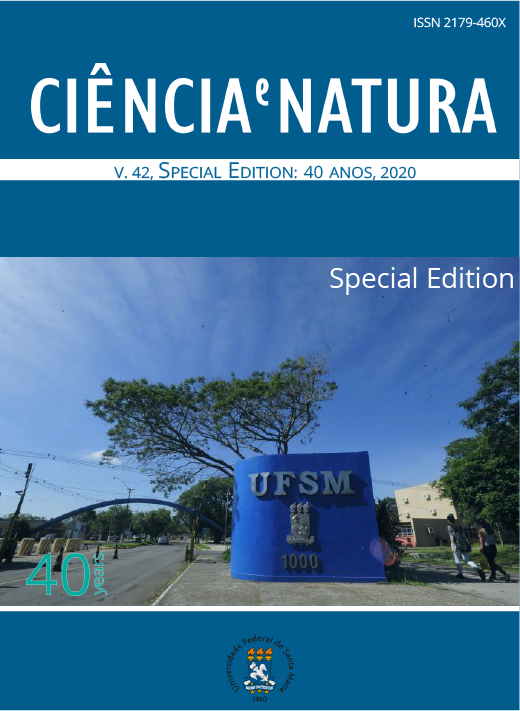Biomatemática: que mistura é essa?
DOI:
https://doi.org/10.5902/2179460X40960Palavras-chave:
Modelos matemáticos, Equações diferenciais, Modelo de Wright-Fisher, Modelo SIR, Crescimento logísticoResumo
Explicamos de maneira bastante introdutória alguns modelos matemáticos para fenômenos da Biologia, mostrando a importância que a Matemática pode ter para o entendimento de algumas questões biológicas. Falamos em particular de modelos para epidemias, crescimento populacional, interações ecológicas e a evolução da espécie humana. Na maior parte do artigo os modelos ilustrados são determinísticos, mas também falamos um pouco sobre modelos estocásticos.Downloads
Referências
@BOOK{BoyceDiPrima,
title = {Equações Diferneciais Elementares e Problemas de Valores de Contorno},
publisher = {LTC},
year = {2015},
author = {Boyce, W. E. and diPrima, R. C.},
edition = {10a}
}
@BOOK{Stewart,
title = {Cálculo},
publisher = {Cengage Learning},
year = {2017},
author = {Stewart, J.},
vol={ 1 e 2},
edition = {8a}
}
@article{greenetal,
author = {Green et al, Richard E.},
title = "A Draft Sequence of the {Neandertal} Genome",
journal = "Science",
volume = "328",
number = "",
pages = "710-722",
year = "2010",
note = "",
doi = "10.1126/science.1188021"
}
@article{nevesserva,
author="Neves, Armando G. M. and Serva, Maurizio",
title="Extremely rare interbreeding events can explain {Neanderthal DNA} in
modern humans",
journal="PLoS ONE",
year="2012",
volume="7",
number="10",
pages="e47076"
}
@BOOK{neves,
title = {Aplicações biológicas de cadeias de {Markov}},
publisher = {III {Colóquio de Matemática da Região Norte}},
year = {2014},
author = {Neves, Armando G. M.}
}
@ARTICLE{nevesmoreira,
author = "Armando G. M. Neves and Carlos H. C. Moreira",
title= "Applications of the Galton-Watson process to
human DNA evolution and demography",
year = "2006",
journal = "Physica A",
volume = "368",
pages = "132"
}
@book{ewens,
title={{Mathematical population genetics}},
author={Ewens, W.J.},
isbn={9783540095774},
lccn={79018938},
series={Biomathematics (Berlin)},
year={1979},
publisher={Springer-Verlag}}
@BOOK{murray,
author = {J. D. Murray},
year = 2002,
title = {Mathematical Biology. An Introduction},
volume={1},
publisher = {Springer}
}
@book{edelstein,
author = {Edelstein-Keshet, Leah},
title = {Mathematical Models in Biology},
year = {2005},
isbn = {0898715547},
publisher = {Society for Industrial and Applied Mathematics},
address = {Philadelphia, PA, USA},
}
@ARTICLE{wikir0,
author = "Wikipedia",
title= "Basic reproduction number",
year = "Acessado em 23/10/2019",
url="https://en.wikipedia.org/wiki/Basic_reproduction_number"
}
Publicado
Como Citar
Edição
Seção
Licença
Para acessar a DECLARAÇÃO DE ORIGINALIDADE E EXCLUSIVIDADE E CESSÃO DE DIREITOS AUTORAIS clique aqui.
Diretrizes Éticas para Publicação de Revistas
A revista Ciência e Natura está empenhada em garantir a ética na publicação e na qualidade dos artigos.
A conformidade com padrões de comportamento ético é, portanto, esperada de todas as partes envolvidas: Autores, Editores e Revisores.
Em particular,
Autores: Os Autores devem apresentar uma discussão objetiva sobre a importância do trabalho de pesquisa, bem como detalhes e referências suficientes para permitir que outros reproduzam as experiências. Declarações fraudulentas ou intencionalmente incorretas constituem comportamento antiético e são inaceitáveis. Artigos de Revisão também devem ser objetivos, abrangentes e relatos precisos do estado da arte. Os Autores devem assegurar que seu trabalho é uma obra totalmente original, e se o trabalho e / ou palavras de outros têm sido utilizadas, isso tem sido devidamente reconhecido. O plágio em todas as suas formas constitui um comportamento publicitário não ético e é inaceitável. Submeter o mesmo manuscrito a mais de um jornal simultaneamente constitui um comportamento publicitário não ético e é inaceitável. Os Autores não devem submeter artigos que descrevam essencialmente a mesma pesquisa a mais de uma revista. O Autor correspondente deve garantir que haja um consenso total de todos os Co-autores na aprovação da versão final do artigo e sua submissão para publicação.
Editores: Os Editores devem avaliar manuscritos exclusivamente com base no seu mérito acadêmico. Um Editor não deve usar informações não publicadas na própria pesquisa do Editor sem o consentimento expresso por escrito do Autor. Os Editores devem tomar medidas de resposta razoável quando tiverem sido apresentadas queixas éticas relativas a um manuscrito submetido ou publicado.
Revisores: Todos os manuscritos recebidos para revisão devem ser tratados como documentos confidenciais. As informações ou ideias privilegiadas obtidas através da análise por pares devem ser mantidas confidenciais e não utilizadas para vantagens pessoais. As revisões devem ser conduzidas objetivamente e as observações devem ser formuladas claramente com argumentos de apoio, de modo que os Autores possam usá-los para melhorar o artigo. Qualquer Revisor selecionado que se sinta desqualificado para rever a pesquisa relatada em um manuscrito ou sabe que sua rápida revisão será impossível deve notificar o Editor e desculpar-se do processo de revisão. Os Revisores não devem considerar manuscritos nos quais tenham conflitos de interesse resultantes de relacionamentos ou conexões competitivas, colaborativas ou outras conexões com qualquer dos autores, empresas ou instituições conectadas aos documentos.






